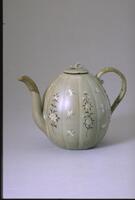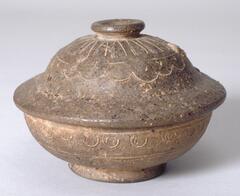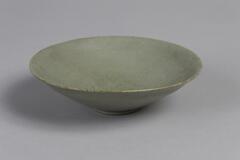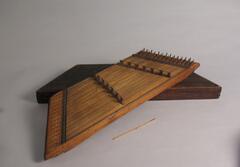372 UMMA Objects
372 UMMA Objects

Korean (Korean (culture or style))
Tea Bowl, 'ido chawan' type
16th century
Bequest of Margaret Watson Parker
1954/1.535
![This stone dagger has a handle that is divided into two parts, separated from each other by a thinner band. The upper tier is smaller in length than the lower tier, which flares outward as it approaches the end. The tip of blade is broken off. In profile, the blade thickens in the center.<br />
<br />
Carved from stone, this dagger with a two-tier handle is missing only its tip. The cross section of the blade is rhomboid, while that of the handle is shaped like a convex lens. The dagger is of the later two-tier-handled type (<em>idanbyeongsik</em>), meaning that it probably dates from the end of the early Bronze Age or the beginning of the middle Bronze Age. Max Loehr (1903- 1988) was a German art historian specializing in East Asian art who taught at the University of Michigan from 1951 to 1960 as a professor.<br />
[Korean Collection, University of Michigan Museum of Art (2017) p.32] This stone dagger has a handle that is divided into two parts, separated from each other by a thinner band. The upper tier is smaller in length than the lower tier, which flares outward as it approaches the end. The tip of blade is broken off. In profile, the blade thickens in the center.<br />
<br />
Carved from stone, this dagger with a two-tier handle is missing only its tip. The cross section of the blade is rhomboid, while that of the handle is shaped like a convex lens. The dagger is of the later two-tier-handled type (<em>idanbyeongsik</em>), meaning that it probably dates from the end of the early Bronze Age or the beginning of the middle Bronze Age. Max Loehr (1903- 1988) was a German art historian specializing in East Asian art who taught at the University of Michigan from 1951 to 1960 as a professor.<br />
[Korean Collection, University of Michigan Museum of Art (2017) p.32]](/media/W1siZiIsIjIwMjIvMDUvMjUvMjhpaWV3MzJmbV9kZWZhdWx0LmpwZyJdLFsicCIsInRodW1iIiwiMjQweDIwMCJdXQ?sha=d2502c4cf43f3c8e)
Korean (Korean (culture or style))
Polished Stone Dagger
900 BCE – 701 BCE
Museum purchase from the collection of Max Loehr
1960/2.117
![<p>This type of bowl was extensively produced throughout the 12th century. The outer wall is decorated with incised and raised deisgn of a two-tiered lotus petal. The glaze was oxidized, producing yellow-green color, but the application of glaze to the entire foot and the use of quartzite spurs indicate that this was produced as a high-quality item.<br />
[<em>Korean Collection, University of Michigan Museum of Art</em> (2014) p.103]</p>
It has a wall gently curving from the mouth toward the bottom before angeling in sharply close to the foot. There is a lotus petal on exterior. The color is brown. <p>This type of bowl was extensively produced throughout the 12th century. The outer wall is decorated with incised and raised deisgn of a two-tiered lotus petal. The glaze was oxidized, producing yellow-green color, but the application of glaze to the entire foot and the use of quartzite spurs indicate that this was produced as a high-quality item.<br />
[<em>Korean Collection, University of Michigan Museum of Art</em> (2014) p.103]</p>
It has a wall gently curving from the mouth toward the bottom before angeling in sharply close to the foot. There is a lotus petal on exterior. The color is brown.](/media/W1siZiIsIjIwMjIvMDUvMjUvMTBnN25oa2prcF9kZWZhdWx0LmpwZyJdLFsicCIsInRodW1iIiwiMjQweDIwMCJdXQ?sha=225012457d334d64)
Korean (Korean (culture or style))
Bowl with carved lotus pattern
12th century
Transfer from the College of Architecture and Design
1972/2.78

Korean (Korean (culture or style))
Ewer in the shape of a melon with inlaid floral and butterfly designs
1100 – 1150
Gift of Mrs. Caroline I. Plumer for the James Marshall Plumer Collection
1973/2.33

Korean (Korean (culture or style))
Cinerary urn with triangular circle-and-dot design
7th century
Gift of Mrs. Caroline I. Plumer for the James Marshall Plumer Collection
1973/2.36A&B
![It has a small straight rim. Abstract flowers is decorated on the shoulder in the cobalt blue. The body shapes octagonal form.<br />
<br />
This white porcelain jar has an octagonal body and is decorated with vignettes in underglaze cobalt blue on the upper part of the shoulder. Its recessed base, created by removing clay from the bottom, retains traces of fine sand support. This angular bottle was shaped using a mold and has a strong sheen. A large number of cracks and contaminants, however, have darkened the surface. The clay is well sintered, forming a sturdy body.<br />
[Korean Collection, University of Michigan Museum of Art (2014) p.175] It has a small straight rim. Abstract flowers is decorated on the shoulder in the cobalt blue. The body shapes octagonal form.<br />
<br />
This white porcelain jar has an octagonal body and is decorated with vignettes in underglaze cobalt blue on the upper part of the shoulder. Its recessed base, created by removing clay from the bottom, retains traces of fine sand support. This angular bottle was shaped using a mold and has a strong sheen. A large number of cracks and contaminants, however, have darkened the surface. The clay is well sintered, forming a sturdy body.<br />
[Korean Collection, University of Michigan Museum of Art (2014) p.175]](/media/W1siZiIsIjIwMjIvMDUvMjUvNWRldWpibGR1MF9kZWZhdWx0LmpwZyJdLFsicCIsInRodW1iIiwiMjQweDIwMCJdXQ?sha=1263f52c62ec2d4b)
Korean (Korean (culture or style))
Small faceted bottle
1850 – 1899
Gift of Mrs. Caroline I. Plumer for the James Marshall Plumer Collection
1977/1.196

Korean (Korean (culture or style))
Blue-and-white octagonal water dropper with floral design
1850 – 1899
Gift of Mrs. Caroline I. Plumer for the James Marshall Plumer Collection
1977/1.197

Korean (Korean (culture or style))
Celadon Bowl
Gift of Margaret Condon Taylor in honor of Professor Kim Young Sook
2014/2.106
![<p>This bowl is typical of early-Goryeo celadon in terms of shape and pattern. Similar examples have been excavated from sedimentary layers from the Kiln no. 10 at Yongun-ri, Gangjin-gun, Jeollanam-do. The entire inner wall is decorated with chrysanthemum sprays incised in fine lines. Chrysanthemum spray design is commonly found in Goryeo celadon produced between the 10th and the 11th centuries along with the motifs of chrysanthemum, scroll, cloud, parrot, and wave. The design is resemblent to those found in Yue ware, but the clay and glaze were sintered better and the glaze was exquisitely fused to turn into the beautiful color without crackles. Six refractory spurs were used to support the bowl during firing. The bowl was restored after a breakage into two halves.<br />
[<em>Korean Collection, University of Michigan Museum of Art </em>(2014) p.92]</p>
<br />
Stoneware bowl with celadon glaze. The bowl is decorated by an incised line stretching parallel to the rim, bounding a chrysanthemum design below. <p>This bowl is typical of early-Goryeo celadon in terms of shape and pattern. Similar examples have been excavated from sedimentary layers from the Kiln no. 10 at Yongun-ri, Gangjin-gun, Jeollanam-do. The entire inner wall is decorated with chrysanthemum sprays incised in fine lines. Chrysanthemum spray design is commonly found in Goryeo celadon produced between the 10th and the 11th centuries along with the motifs of chrysanthemum, scroll, cloud, parrot, and wave. The design is resemblent to those found in Yue ware, but the clay and glaze were sintered better and the glaze was exquisitely fused to turn into the beautiful color without crackles. Six refractory spurs were used to support the bowl during firing. The bowl was restored after a breakage into two halves.<br />
[<em>Korean Collection, University of Michigan Museum of Art </em>(2014) p.92]</p>
<br />
Stoneware bowl with celadon glaze. The bowl is decorated by an incised line stretching parallel to the rim, bounding a chrysanthemum design below.](/media/W1siZiIsIjIwMjIvMDkvMjQvM2djdWZxdmhieV9kZWZhdWx0LmpwZyJdLFsicCIsInRodW1iIiwiMjQweDIwMCJdXQ?sha=8591e65ef730993a)
Korean (Korean (culture or style))
Bowl with Chrysanthemum Design
900 – 1099
Gift of Bruce and Inta Hasenkamp and Museum purchase made possible by Elder and Mrs. Sang-Yong Nam
2004/1.220
![<p>This bowl has a narrow foot and a ared mouth. is type of bowl was produced in large quantities from the 11th century to the 12th century. Its inner wall has mold-impressed peony sprays. The entire body of the bowl is glazed, including the inside of the foot, but the glaze on its rim of the foot was wiped away, on which refractory spurs were adhered to for ring. Parts of the inner surface show ne crackles, while the inner bottom was stained with greenish-brown iron spots. One part of the rim was damaged and subsequently repaired. Glaze applied to the outer surface has partially owed downwards, resulting in an uneven surface, but the glaze and clay are quite well fused and sintered.<br />
[<em>Korean Collection, University of Michigan Museum of Art</em> (2014) p.93]</p>
<br />
The celadon bowl has straight-lined sides. The surface is evenly coated with a dark bluish green glaze. The celadon bowl rests on a rather tall foot, which was hollowed out from the bottom. The designs are present only on the inside <p>This bowl has a narrow foot and a ared mouth. is type of bowl was produced in large quantities from the 11th century to the 12th century. Its inner wall has mold-impressed peony sprays. The entire body of the bowl is glazed, including the inside of the foot, but the glaze on its rim of the foot was wiped away, on which refractory spurs were adhered to for ring. Parts of the inner surface show ne crackles, while the inner bottom was stained with greenish-brown iron spots. One part of the rim was damaged and subsequently repaired. Glaze applied to the outer surface has partially owed downwards, resulting in an uneven surface, but the glaze and clay are quite well fused and sintered.<br />
[<em>Korean Collection, University of Michigan Museum of Art</em> (2014) p.93]</p>
<br />
The celadon bowl has straight-lined sides. The surface is evenly coated with a dark bluish green glaze. The celadon bowl rests on a rather tall foot, which was hollowed out from the bottom. The designs are present only on the inside](/media/W1siZiIsIjIwMjIvMDkvMjQvOWpqdXU4d2plel9kZWZhdWx0LmpwZyJdLFsicCIsInRodW1iIiwiMjQweDIwMCJdXQ?sha=d6b4e1202cb44ca4)
Korean (Korean (culture or style))
Conical bowl with molded floral design
12th century
Gift of Bruce and Inta Hasenkamp and Museum purchase made possible by Elder and Mrs. Sang-Yong Nam
2004/1.222

Korean (Korean (culture or style))
Hammer-dulcimer (Yanggeum)
1850 – 1950
Gift and partial purchase from Bruce and Inta Hasenkamp, purchase with funds from Elder and Mrs Sang-Yong Nam
2021/1.158
![The mouth is straight. The side is gently curved to the bottom. The foot is hgh and narrow. It was repaired.<br />
<br />
Produced between the 15th and 16th century at a privately owned kiln in the southwestern region of Gyeongsangnam-do, this bowl has been restored following breakage into ten pieces. Its rim curves inwards. It is made with stoneware clay. There are five spur marks on the inner base, and the glaze on the rim of its foot has been wiped away. It is coated with opaque white glaze, on which have formed many crackles and pinholes. The color of glaze is not even throughout the surface. Vessels of this type were popular in Japan as tea bowls (茶碗, Jap. chawan).<br />
[Korean Collection, University of Michigan Museum of Art (2014) p.160] The mouth is straight. The side is gently curved to the bottom. The foot is hgh and narrow. It was repaired.<br />
<br />
Produced between the 15th and 16th century at a privately owned kiln in the southwestern region of Gyeongsangnam-do, this bowl has been restored following breakage into ten pieces. Its rim curves inwards. It is made with stoneware clay. There are five spur marks on the inner base, and the glaze on the rim of its foot has been wiped away. It is coated with opaque white glaze, on which have formed many crackles and pinholes. The color of glaze is not even throughout the surface. Vessels of this type were popular in Japan as tea bowls (茶碗, Jap. chawan).<br />
[Korean Collection, University of Michigan Museum of Art (2014) p.160]](/media/W1siZiIsIjIwMjIvMDUvMjUvM3R0eDR5eWgyY19kZWZhdWx0LmpwZyJdLFsicCIsInRodW1iIiwiMjQweDIwMCJdXQ?sha=d5380f150dce8f41)
Korean (Korean (culture or style))
Deep footed bowl
16th century
Transfer from the College of Architecture and Design
1972/2.75
Loading…
